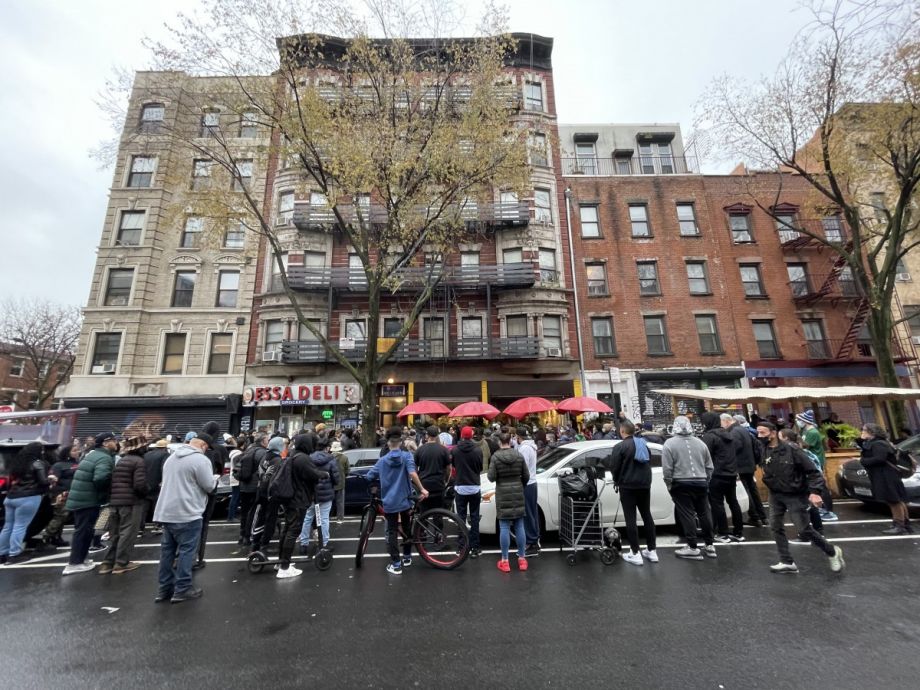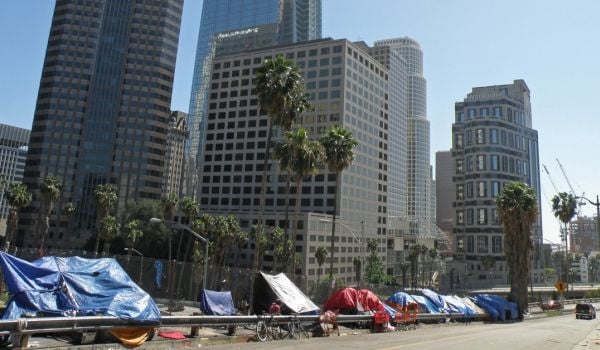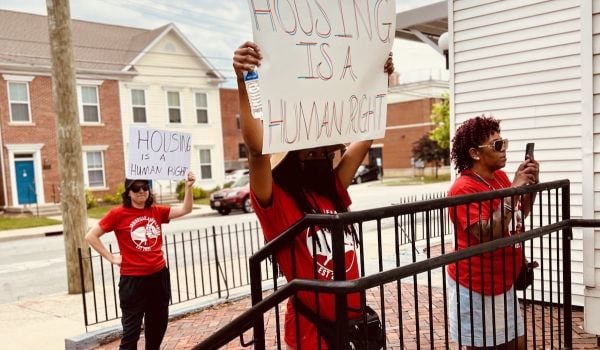On an overcast Saturday in December, a crowd of 200 or so gathered in front of 66 Avenue C on Manhattan’s Lower East Side. Local cultural icon and activist Power Malu took the microphone and directed everyone’s attention to the word “HOMESTEADERS” spelled out in tile letters above the front door of the six-story red brick apartment building behind him — and on many other buildings in the neighborhood.
The crowd was there for a rally to save Casa Adela, the Puerto Rican restaurant that has been in one of the building’s two storefronts for longer than some of its residents, but is now under threat of closing due to a rent dispute with the building’s owners — who happen to be the residents of the building itself.
As Malu recounted to the crowd, some of whom had lived through the story themselves, the building is one of many in the neighborhood that landlords had neglected and eventually abandoned in the 1970s and 80s, going through foreclosure and into the hands of the city. 66 Avenue C was abandoned in 1977. Under the program that became known as “urban homesteading,” homesteaders could put in “sweat equity,” contributing their own labor to help restore dilapidated buildings, and in exchange the city would sell those buildings to them as co-ops for just $250 a unit.
Like Adela Fargas, Casa Adela’s founder and namesake, many urban homesteaders on the Lower East Side came from Puerto Rico — giving rise to the hybrid Spanish-English neighborhood moniker, “Loisaida.” This stretch of Avenue C is even co-designated “Loisaida Avenue.” Business owners occasionally chipped in to help restore storefronts — though there was never a path for commercial tenants to own the spaces they helped restore as renters. Casa Adela had opened a few doors down in 1976, and moved into 66 Avenue C while homesteaders were still working on the building in the 1980s.
“This place was earned, not given,” Malu said at the rally. “Adela, her family and people that still live in this building worked to restore, rehabilitate and fix the conditions of this building, including the space that is now Casa Adela. That was an empty space, ain’t nobody else wanted it. Adela earned this because she was on the street feeding the community.”
It’s hardly the kind of situation where you’d expect a community to have to rally against a rent hike that threatens to close a beloved local business. But today the 118-year-old building needs significant repairs for which it has to pay somehow. Knowing that, the restaurant offered to hike up its current rent by more than 200%, plus annual 3% increases for the next 10 years, but the co-op board says it needs more. Were it not for a state-ordered moratorium on evicting commercial tenants affected by the pandemic, Casa Adela would already be gone.
At the rally, the news spread that after months of silence, the co-op board had finally returned to the negotiating table, and that local council member Carlina Rivera had joined the negotiations to offer what resources the city might have to save the restaurant as well as meet the co-op’s needs. The parties have yet to reach an agreement. A court date is set for later this month.
Council Member Rivera would rather communities like these not have to mount a rally every time they are at risk of losing a beloved local business. It’s why she’s been among those calling for some form of commercial rent regulation to alter the market dynamics that have already led to the closures of so many beloved local businesses across the city and threaten those that are left, in co-ops as well as conventionally owned buildings.
“Out of all of the tools we are using so far, nothing seems to be working to keep local retail alive,” Rivera tells Next City.
In the struggle of storefront tenants facing exorbitant rent hikes, profit-hungry landlords or real estate speculators are easy villains to paint. The case of Casa Adela and 66 Avenue C reveals a more complicated picture. The behavior of those other actors has a way of enabling similar choices by co-ops with different motivations.
“We have two issues here, a struggling restaurant that is in desperate need of financial support and might need to pivot their business in order to meet 21st-century demand, and then we have a building that is in need of capital repairs,” Rivera says.
Residents raising monthly co-op fees on themselves is a tough choice to consider, especially for those that remain dedicated by choice or by legal agreement to serve low-income residents.
A Bloomberg article earlier this year reported on some co-op units occasionally selling for high-six and even seven-figure sums to children of wealthy families who happen to have low-paying jobs or careers — raising big bucks for the co-op because co-op rules can split the resale price between the building and the previous owner of the unit. But as the Bloomberg article notes, such sales put into question the validity of the city’s tax breaks for co-ops intended to serve low-to-moderate income households, known as Housing Development Fund Corporations, or HDFC cooperatives.
There are more than 1,100 HDFC co-ops around New York City, and an estimated 27% are in financial distress, according to the city’s Department of Housing Preservation and Development. 66 Avenue C is an HDFC co-op.
Co-ops with storefront spaces can catch word through brokers or other real estate professionals that nearby buildings have been renting out their storefronts at much higher rates. And unlike the highly regulated residential leasing landscape, the commercial leasing landscape is still a wild west by comparison.
Many New York storefront tenants don’t even have a lease, just a handshake agreement with their landlord. Casa Adela hasn’t had a lease since 2012. According to Luis Rivera, the restaurant founder’s son, who along with his sister took over ownership after their mother passed away in 2018, that’s when the last formal lease for the restaurant expired.
Under that former lease, the restaurant was paying $1,380 a month for the restaurant’s 715-square-foot space. It’s also when Superstorm Sandy hit, putting much of the neighborhood under a foot or more of storm surge. Rivera (no relation to the council member) says he wanted to negotiate a new lease but the board never came around to it, and the restaurant has since continued to pay the same $1,380 a month without a lease.
In 2018, after his mother passed away, Rivera got help from TakeRoot Justice, a legal aid group with funding from the city’s Commercial Lease Assistance Program, to submit a request to the board for a lease, proposing to pay $2,000 a month for the first five years, $2,400 a month for the next five. The board didn’t reply to his offer, but neither did it ask for more rent at the time.
Earlier this year Rivera again requested a lease, offering to pay $3,000 a month plus 3% annual increases for 10 years. The board’s counter-offer: a 10-year lease, $3,000 a month in year one, then $6,750 in year two followed by 3% annual increases. That’s a 500% increase from the restaurant’s current rent.
Without a lease, Rivera has been unable to apply for small business aid — not after Sandy and not during the pandemic.
“There’s no protection for commercial tenants, there’s not even a right to lease renewal,” says Val Orselli, co-founder and former director of Cooper Square Community Land Trust and Cooper Square Mutual Housing Association, which encompass 21 HDFC co-op apartment buildings with 24 storefronts scattered around the nearby East Village neighborhood.
Orselli says residents of Cooper Square buildings have kept its commercial tenants local and independent by leasing out storefronts at rates below what the buildings could potentially get from other tenants. They’ve accepted lower commercial rents in exchange for what those local commercial tenants bring to the community.
“We always had multiple applicants for open storefronts, and tried to bring in individual mom and pop stores, not chains, because they provide more than commercial activity,” Orselli says. “They stay open late and become an essential part of the community.”
But over the years even at Cooper Square buildings there have occasionally been board members calling for the highest possible rent from commercial tenants. “They’ve just never been the majority,” Orselli says.
It’s not clear that 66 Avenue C could even find a tenant right now at the price the co-op board is asking, but they remain convinced. The temptation for co-ops to tap into commercial rent euphoria is a constant, apparently even in the midst of a pandemic that has shaken brick and mortar retail and especially restaurants to their core.
Council Member Rivera says the city bears some responsibility to get more resources to HDFC co-ops to address their needs, but it can’t do it alone — the state and federal government also bear some of that responsibility. In the meantime, she also believes some form of commercial rent regulation is necessary to detoxify a real estate market now pitting low-income residents against beloved local businesses.
There are two different commercial rent regulation proposals currently stalled in city council. They approach regulation in different ways. Rivera says she would support a version of either to pass.
There’s the Small Business Jobs Survival Act, a version of which was first proposed in city council back in 1984. It would grant commercial tenants a right to a lease renewal, as well as a mandate for binding third-party arbitration to settle cases where landlords justifiably must up rent by a certain amount to cover higher property taxes or maintenance costs, but tenants oppose exorbitant rent increases that they believe reflect irrational speculation as opposed to the economics of a given location.
The second proposal, introduced in city council back in 2019, would set up a commercial rent guidelines board, similar to the existing Rent Guidelines Board for rent-stabilized apartments. The commercial rent guidelines board would determine annual rates of allowed rental adjustments for commercial tenants. Going beyond just storefronts, under the current version of the bill would cover all retail or office spaces of up to 10,000 square feet and manufacturing spaces up to 25,000 square feet.
Both proposals count support from different coalitions of small businesses owners around the city. But it’s been clear from council committee hearings on either bill that if passed, legal challenges were certain to come from opponents who argue the city doesn’t have legal authority from the state to regulate commercial leasing.
Real estate industry lobbyists have long vehemently opposed any form of commercial rent regulation. Part of the opposition is ideological — commercial rent control is seen as government meddling in private affairs of the market.
But there are practical concerns like the rising cost of maintaining very old buildings. Not to mention the one million rent-stabilized apartment units in the city, about a quarter of the city’s housing stock, which leaves their buildings even more reliant on commercial rent to rise with the cost of maintenance and property taxes. The city’s Rent Guidelines Board was notoriously stingy under the De Blasio administration, nearly freezing rents for rent-stabilized units after years of regular increases under the Bloomberg administration.
The case of Casa Adela and 66 Avenue C illustrates that even if you take the profit-hungry landlord out of the equation, beloved local businesses can still end up as collateral damage.
New York City did have commercial rent stabilization in place from 1945 to 1963. It was a state law, and legislators allowed it to expire.
“If you think landlords get upset about residential rent control or stabilization, that’s nothing compared to anything having to do with commercial rent,” Orselli says.
EDITOR’S NOTE: This end of this story was updated to reflect that NYC’s commercial rent stabilization from 1945 to 1963 was a state law, and that legislators allowed the program to expire.
This article is part of The Bottom Line, a series exploring scalable solutions for problems related to affordability, inclusive economic growth and access to capital. Click here to subscribe to our Bottom Line newsletter.

Oscar is Next City's senior economic justice correspondent. He previously served as Next City’s editor from 2018-2019, and was a Next City Equitable Cities Fellow from 2015-2016. Since 2011, Oscar has covered community development finance, community banking, impact investing, economic development, housing and more for media outlets such as Shelterforce, B Magazine, Impact Alpha and Fast Company.
Follow Oscar .(JavaScript must be enabled to view this email address)


















